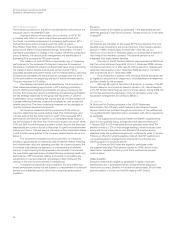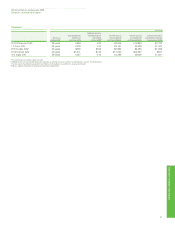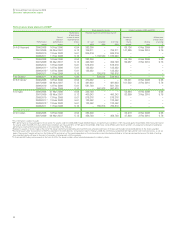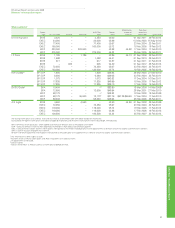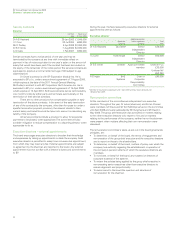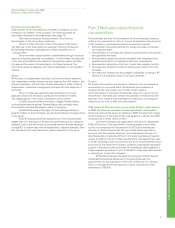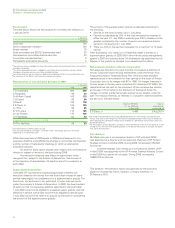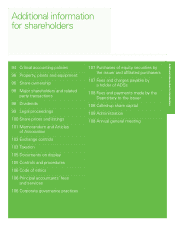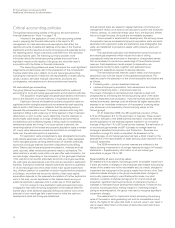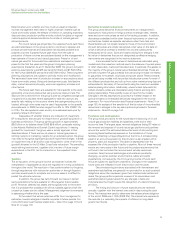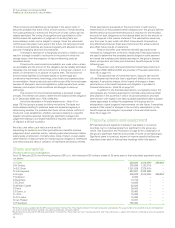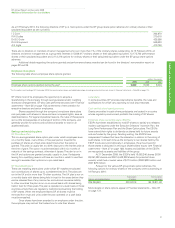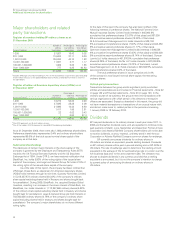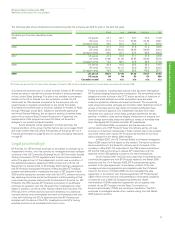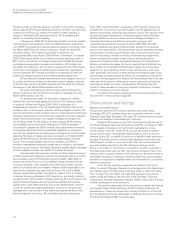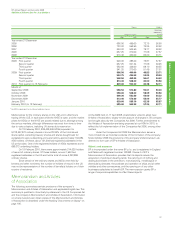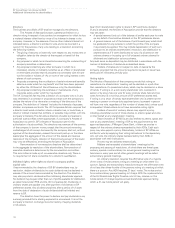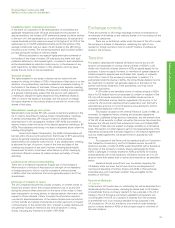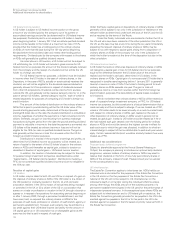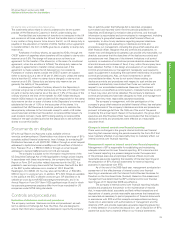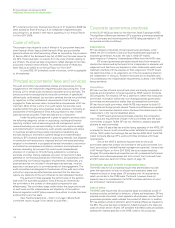BP 2009 Annual Report Download - page 98
Download and view the complete annual report
Please find page 98 of the 2009 BP annual report below. You can navigate through the pages in the report by either clicking on the pages listed below, or by using the keyword search tool below to find specific information within the annual report.
96
Other provisions and liabilities are recognized in the period when it
becomes probable that there will be a future outflow of funds resulting
from past operations or events and the amount of cash outflow can be
reliably estimated. The timing of recognition and quantification of the
liability require the application of judgement to existing facts and
circumstances, which can be subject to change. Since the actual cash
outflows can take place many years in the future, the carrying amounts
of provisions and liabilities are reviewed regularly and adjusted to take
account of changing facts and circumstances.
A change in estimate of a recognized provision or liability would
result in a charge or credit to net income in the period in which the
change occurs (with the exception of decommissioning costs as
described above).
Provisions for environmental remediation are made when a clean-
up is probable and the amount of the obligation can be reliably estimated.
Generally, this coincides with commitment to a formal plan of action or, if
earlier, on divestment or on closure of inactive sites. The provision for
environmental liabilities is estimated based on current legal and
constructive requirements, technology, price levels and expected plans
for remediation. Actual costs and cash outflows can differ from estimates
because of changes in laws and regulations, public expectations, prices,
discovery and analysis of site conditions and changes in clean-up
technology.
The provision for environmental liabilities is reviewed at least
annually. The interest rate used to determine the balance sheet obligation
at 31 December 2009 was 1.75% (2008 2%).
As further described in Financial statements – Note 41 on
page 176, the group is subject to claims and actions. The facts and
circumstances relating to particular cases are evaluated regularly in
determining whether it is probable that there will be a future outflow of
funds and, once established, whether a provision relating to a specific
litigation should be adjusted. Accordingly, significant management
judgement relating to contingent liabilities is required, since the outcome
of litigation is difficult to predict.
Pensions and other post-retirement benefits
Accounting for pensions and other post-retirement benefits involves
judgement about uncertain events, including estimated retirement dates,
salary levels at retirement, mortality rates, rates of return on plan assets,
determination of discount rates for measuring plan obligations, healthcare
cost trend rates and rates of utilization of healthcare services by retirees.
These assumptions are based on the environment in each country.
Determination of the projected benefit obligations for the group’s defined
benefit pension and post-retirement plans is important to the recorded
amounts for such obligations on the balance sheet and to the amount of
benefit expense in the income statement. The assumptions used may
vary from year to year, which will affect future results of operations.
Any differences between these assumptions and the actual outcome
also affect future results of operations.
Pension and other post-retirement benefit assumptions are
reviewed by management at the end of each year. These assumptions
are used to determine the projected benefit obligation at the year-end
and hence the surpluses and deficits recorded on the group’s balance
sheet, and pension and other post-retirement benefit expense for the
following year.
The pension and other post-retirement benefit assumptions at
December 2009, 2008 and 2007 are provided in Financial statements –
Note 35 on page 161.
The assumed rate of investment return, discount rate and the
US healthcare cost trend rate have a significant effect on the amounts
reported. A sensitivity analysis of the impact of changes in these
assumptions on the benefit expense and obligation is provided in
Financial statements – Note 35 on page 161.
In addition to the financial assumptions, we regularly review the
demographic and mortality assumptions. Mortality assumptions reflect
best practice in the countries in which we provide pensions and have
been chosen with regard to the latest available published tables adjusted
where appropriate to reflect the experience of the group and an
extrapolation of past longevity improvements into the future. A sensitivity
analysis of the impact of changes in the mortality assumptions on the
benefit expense and obligation is provided in Financial statements –
Note 35 on page 161.
Property, plants and equipment
BP has freehold and leasehold interests in real estate in numerous
countries, but no individual property is significant to the group as a
whole. See Exploration and Production on page 22 for a description of
the group’s significant reserves and sources of crude oil and natural gas.
Significant plans to construct, expand or improve specific facilities are
described under each of the business headings within this section.
Share ownership
Directors and senior management
As at 18 February 2010, the following directors of BP p.l.c. held interests in BP ordinary shares of 25 cents each or their calculated equivalent as set
out below:
I C Conn 349,820 2,016,005a266,904b
R W Dudley 276,846 1,120,716a–
Dr B E Grote 1,351,529 2,376,570a–
Dr A B Hayward 622,807 3,022,598a–
A G Inglis 308,639 2,016,005a266,904b
P Anderson 6,000 – –
A Burgmans 10,156 – –
C B Carroll 10,500 – –
Sir William Castell 82,500 – –
G David 39,000 – –
E B Davis, Jr 76,497 – –
D J Flint 15,000 – –
Dr D S Julius 15,000 – –
Sir Ian Prosser 16,301 – –
C-H Svanberg 750,000 – –
aPerformance shares awarded under the BP Executive Directors’ Incentive Plan. These figures represent the maximum possible vesting levels. The actual number of shares/ADSs that vest will depend on
the extent to which performance conditions have been satisfied over a three-year period.
bRestricted share award under the BP Executive Directors’ Incentive Plan. These shares will vest in two equal tranches after three and five years, subject to the directors’ continued service and satisfactory
performance.
BP Annual Report and Accounts 2009
Additional information for shareholders


